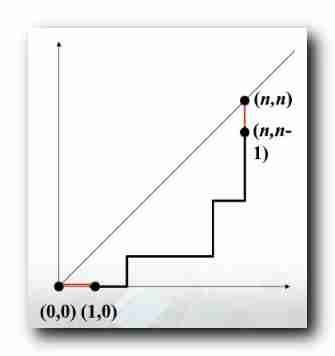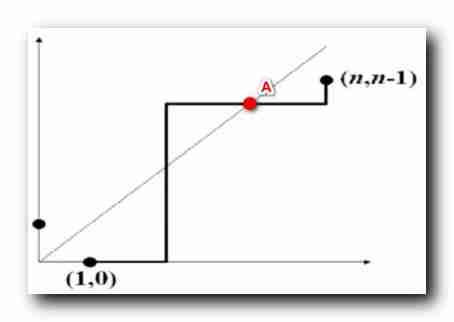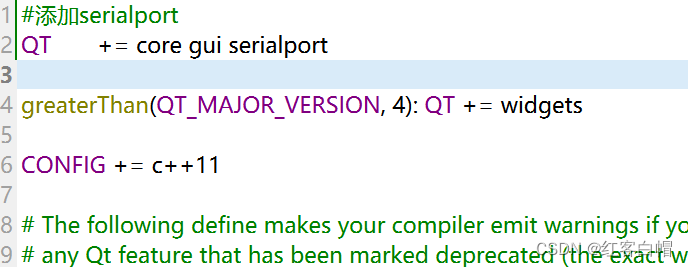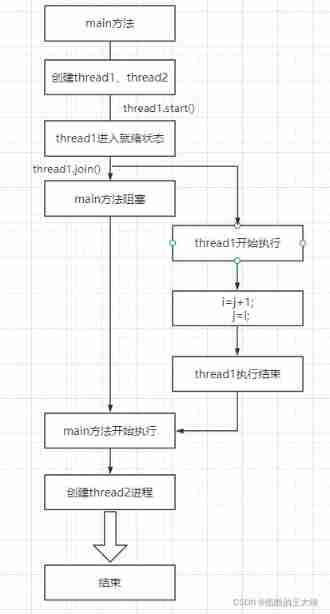当前位置:网站首页>[combinatorics] non descending path problem (number of non descending paths with constraints)
[combinatorics] non descending path problem (number of non descending paths with constraints)
2022-07-03 16:30:00 【Programmer community】
One 、 The number of non descending paths of the constraint

from
(
0
,
0
)
(0,0)
(0,0) To
(
n
,
n
)
(n,n)
(n,n) Except endpoint , The number of non descending paths that do not touch the diagonal ?
At this time, the basic formula cannot be used for processing , You must use the idea of combining correspondence ;
In the example above , from
(
0
,
0
)
(0,0)
(0,0) Set out to
(
n
,
n
)
(n,n)
(n,n) , There are only two endpoints
(
0
,
0
)
(0,0)
(0,0) and
(
n
,
n
)
(n,n)
(n,n) Touching the diagonal , Every step in the middle does not touch the diagonal ;
1 . Calculation principle , First calculate the non descending path below the diagonal : Here, only the number of non descending paths below the diagonal is counted , because The non descending path above and below the diagonal is symmetric , So here First calculate the non descending path below the diagonal ;
The non descending path below the diagonal multiply
2
2
2 , That's all Not touching the diagonal Number of non descending paths ;
2 . Starting point analysis : from
(
0
,
0
)
(0,0)
(0,0) After departure , The first
1
1
1 Step must go to the right , Go to the
(
1
,
0
)
(1, 0)
(1,0) spot , If you go up, you can't come down anymore ( Otherwise, it will touch the diagonal ) , At this time, it is not the non descending path below the diagonal ;
3 . End point analysis :
arrive
(
n
,
n
)
(n,n)
(n,n) spot , There are only two cases :
- Above the diagonal : One case is from the left
(
n
−
1
,
n
)
(n-1 , n)
(n−1,n) To the right
(
n
,
n
)
(n,n)
(n,n) spot , The path is above the diagonal ;
- Below the diagonal : One situation is from the bottom
(
n
,
n
−
1
)
(n , n-1)
(n,n−1) To the top
(
n
,
n
)
(n,n)
(n,n) spot , The path is below the diagonal ;
At present, only The number of non descending paths below the diagonal , arrive
(
n
,
n
)
(n,n)
(n,n) The previous step , Must be from
(
n
,
n
−
1
)
(n,n-1)
(n,n−1) Position go to
(
n
,
n
)
(n,n)
(n,n) Of ;
4 . Corresponding relation
Above You must leave after the starting point
(
1
,
0
)
(1, 0)
(1,0) spot , You must go before the end
(
n
,
n
−
1
)
(n,n-1)
(n,n−1) spot ,
therefore Below the diagonal from
(
0
,
0
)
(0,0)
(0,0) To
(
n
,
n
)
(n,n)
(n,n) Except endpoint , The number of non descending paths that do not touch the diagonal
Equivalent to
from
(
1
,
0
)
(1, 0)
(1,0) To
(
n
,
n
−
1
)
(n,n-1)
(n,n−1) Except endpoint , The number of non descending paths that do not touch the diagonal
5 . Calculation
(
1
,
0
)
(1, 0)
(1,0) To
(
n
,
n
−
1
)
(n,n-1)
(n,n−1) Except endpoint , The number of non descending paths that do not touch the diagonal
Let's talk about “ from
(
1
,
0
)
(1, 0)
(1,0) To
(
n
,
n
−
1
)
(n,n-1)
(n,n−1) Except endpoint , The number of non descending paths that do not touch the diagonal ” How to count ;
Think in reverse , Statistics from
(
1
,
0
)
(1, 0)
(1,0) To
(
n
,
n
−
1
)
(n,n-1)
(n,n−1) Between , The non descending path that touches the diagonal , The rest is the path that does not touch the diagonal ;
The total of the above two is
C
(
2
n
−
2
,
n
−
1
)
C(2n-2 , n-1)
C(2n−2,n−1) individual ;

Above, One “ from
(
1
,
0
)
(1, 0)
(1,0) To
(
n
,
n
−
1
)
(n,n-1)
(n,n−1) , The non descending path that touches the diagonal ” ,
In the picture Red dot
A
A
A Is the position where the non descending path finally contacts the diagonal , The front may touch the diagonal many times ;
take
(
1
,
0
)
(1, 0)
(1,0) spot And
A
A
A spot Blue line segment between , Make a symmetrical image about the diagonal , obtain Red line ,

In the picture above Blue line segment The starting point is
(
1
,
0
)
(1,0)
(1,0), So the corresponding The starting point of the red line segment must be
(
0
,
1
)
(0,1)
(0,1) ;
Every one from
(
1
,
0
)
(1,0)
(1,0) Start to
(
n
,
n
−
1
)
(n, n-1)
(n,n−1) The non descending path of the contact diagonal , There are blue line segments , Can use symmetrical method , Get one from
(
0
,
1
)
(0,1)
(0,1) arrive
A
A
A The red line segment of the dot ;
Here we get a combinatorial correspondence :
Each from
(
0
,
1
)
(0,1)
(0,1) set out , To
(
n
,
n
−
1
)
(n, n-1)
(n,n−1) Of Non descending path ( the Red line segment And remainder Black line segment Paths that can be spliced )
Can and
from
(
1
,
0
)
(1,0)
(1,0) set out , To
(
n
,
n
−
1
)
(n, n-1)
(n,n−1) Contact diagonal Non descending path
One-to-one correspondence ;
So if required " from
(
1
,
0
)
(1,0)
(1,0) set out , To
(
n
,
n
−
1
)
(n, n-1)
(n,n−1) Contact diagonal Number of non descending paths " , You can ask for “ from
(
0
,
1
)
(0,1)
(0,1) set out , To
(
n
,
n
−
1
)
(n, n-1)
(n,n−1) Of Number of non descending paths ” ;
“ from
(
0
,
1
)
(0,1)
(0,1) set out , To
(
n
,
n
−
1
)
(n, n-1)
(n,n−1) Of Number of non descending paths ” You can use formulas to calculate , The result is
C
(
2
n
−
2
,
n
)
C(2n - 2 , n)
C(2n−2,n) ,
Corresponding " from
(
1
,
0
)
(1,0)
(1,0) set out , To
(
n
,
n
−
1
)
(n, n-1)
(n,n−1) Contact diagonal Number of non descending paths " , The result is
C
(
2
n
−
2
,
n
)
C(2n - 2 , n)
C(2n−2,n) ;
6 . Calculation
(
1
,
0
)
(1, 0)
(1,0) To
(
n
,
n
−
1
)
(n,n-1)
(n,n−1) The number of all non descending paths
Calculate according to the formula , The result is :
C
(
2
n
−
2
,
n
−
1
)
C(2n - 2 , n-1)
C(2n−2,n−1)
7 . Calculation
(
1
,
0
)
(1, 0)
(1,0) To
(
n
,
n
−
1
)
(n,n-1)
(n,n−1) Except endpoint , The number of non descending paths that do not touch the diagonal
"
(
1
,
0
)
(1, 0)
(1,0) To
(
n
,
n
−
1
)
(n,n-1)
(n,n−1) Except endpoint , The number of non descending paths that do not touch the diagonal " Namely
"
(
1
,
0
)
(1, 0)
(1,0) To
(
n
,
n
−
1
)
(n,n-1)
(n,n−1) The number of all non descending paths " subtract "
(
1
,
0
)
(1, 0)
(1,0) To
(
n
,
n
−
1
)
(n,n-1)
(n,n−1) Except endpoint , The number of non descending paths that do not touch the diagonal " ;
C
(
2
n
−
2
,
n
−
1
)
−
C
(
2
n
−
2
,
n
)
\ \ \ \ C(2n - 2 , n-1) - C(2n - 2 , n)
C(2n−2,n−1)−C(2n−2,n)
=
(
2
n
−
2
n
−
1
)
−
(
2
n
−
2
n
)
=\dbinom{2n - 2}{n-1} - \dbinom{2n - 2}{n}
=(n−12n−2)−(n2n−2)
8 . Calculation from
(
0
,
0
)
(0,0)
(0,0) To
(
n
,
n
)
(n,n)
(n,n) Except endpoint , The number of non descending paths that do not touch the diagonal
above
(
2
n
−
2
n
−
1
)
−
(
2
n
−
2
n
)
\dbinom{2n - 2}{n-1} - \dbinom{2n - 2}{n}
(n−12n−2)−(n2n−2) It only calculates the number of non descending paths below the diagonal ,
from
(
0
,
0
)
(0,0)
(0,0) set out , To
(
n
,
n
)
(n,n)
(n,n) The number of non descending paths that do not touch the diagonal , Multiplied by
2
2
2 , You get the final result of this topic ;
from
(
0
,
0
)
(0,0)
(0,0) To
(
n
,
n
)
(n,n)
(n,n) Except endpoint , The number of non descending paths that do not touch the diagonal
The end result is :
2
[
(
2
n
−
2
n
−
1
)
−
(
2
n
−
2
n
)
]
2[\dbinom{2n - 2}{n-1} - \dbinom{2n - 2}{n}]
2[(n−12n−2)−(n2n−2)]
边栏推荐
- 程序猿如何快速成长
- Cocos Creator 2. X automatic packaging (build + compile)
- 什么是质押池,如何进行质押呢?
- 在ntpdate同步时间的时候出现“the NTP socket is in use, exiting”
- TCP congestion control details | 3 design space
- Myopia: take off or match glasses? These problems must be understood clearly first
- Chinese translation of Tagore's floating birds (1~10)
- Hong Kong Polytechnic University | data efficient reinforcement learning and adaptive optimal perimeter control of network traffic dynamics
- Is it safe to open an account with tongdaxin?
- From the 18th line to the first line, the new story of the network security industry
猜你喜欢

Myopia: take off or match glasses? These problems must be understood clearly first

How to use AAB to APK and APK to AAB of Google play apps on the shelves

QT串口ui设计和解决显示中文乱码

拼夕夕二面:说说布隆过滤器与布谷鸟过滤器?应用场景?我懵了。。

Multithread 02 thread join

arduino-esp32:LVGL项目(一)整体框架
![[web security] - [SQL injection] - error detection injection](/img/18/5c511871dab0e5c684b6b4c081c061.jpg)
[web security] - [SQL injection] - error detection injection

斑馬識別成狗,AI犯錯的原因被斯坦福找到了
![[solved] access denied for user 'root' @ 'localhost' (using password: yes)](/img/71/1ff8ed1d773da99054310f96dca3f8.jpg)
[solved] access denied for user 'root' @ 'localhost' (using password: yes)

Visual SLAM algorithms: a survey from 2010 to 2016
随机推荐
Nifi from introduction to practice (nanny level tutorial) - flow
Unity project optimization case 1
Effect of ARP package on FTP dump under vxworks-6.6 system
远程办公之大家一同实现合作编辑资料和开发文档 | 社区征文
Pychart error updating package list: connect timed out
PHP CI(CodeIgniter)log级别设置
2022 love analysis · panoramic report of digital manufacturers of state-owned enterprises
How to initialize views when loading through storyboards- How is view initialized when loaded via a storyboard?
(Supplement) double pointer topic
8 tips for effective performance evaluation
线程池执行定时任务
From "zero sum game" to "positive sum game", PAAS triggered the third wave of cloud computing
Deep understanding of grouping sets statements in SQL
Visual SLAM algorithms: a survey from 2010 to 2016
关于视觉SLAM的最先进技术的调查-A survey of state-of-the-art on visual SLAM
Characteristic polynomial and constant coefficient homogeneous linear recurrence
Aike AI frontier promotion (7.3)
近视:摘镜or配镜?这些问题必须先了解清楚
Slam learning notes - build a complete gazebo multi machine simulation slam from scratch (4)
Getting started with Message Oriented Middleware